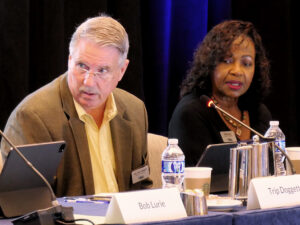INDIANAPOLIS — The MISO Board of Directors hit the high notes of resource adequacy anxiety, a possible board addition with experience at Southern California Edison and an annual budget that will creep past $400 million for the first time.
More Supply Alarms
In what’s becoming a familiar refrain, Senior Vice President of Markets and Digital Strategy Todd Ramey cautioned board members that MISO’s capacity soon will fall short of serving ever-increasing load.
MISO needs a “dramatically accelerated pace of new build,” Ramey said at a Sept. 19 board meeting. He stressed the RTO needs dispatchable, long-duration resources, noting that member plans submitted under MISO’s 2024 Regional Resource Assessment show anticipated additions primarily are weather-dependent.
Ramey said members should consider “deferring retirements until other options are available.” He also said members might question whether their clean energy goals “balance and add up well” against reliability requirements. He said some could relax target time frames.
“Without delays we’ve had to date, we’d be in a whole lot of trouble,” MISO Director Todd Raba said.
However, MISO Director Mark Johnson said retirement delays should be considered “as short-term lever.”
Director Phyllis Currie agreed retirement postponement should be a “short-term step” especially considering the threat of climate change and that MISO “should demonstrate an openness” to new technologies. “I think our posture has to be one that we don’t sound like we’re counting on delays.”
Ramey added that MISO is sitting on 55 GW of projects with approved interconnection agreements but that remain unfinished, stalled largely by lurching supply chains.
Tyler Huebner, formerly of the Wisconsin Public Service Commission and now with Google, said load growth from computing and manufacturing presents the U.S. with an opportunity to “reinforce” its reputation for ingenuity and intrepidness.
Huebner said Google is working with MISO members to identify the most appropriate locations to site facilities and is working on creative solutions to unlock new capacity.
“We strive to be good grid citizens,” he said.
MISO and its directors are set to discuss the footprint’s load growth trajectory through 2030 and the changing resource portfolio at a nonpublic MISO Board Strategic Planning Session near Seattle on Oct. 28.
Southern California Edison Retiree Poised to Join Board
MISO members will vote on whether to install two familiar faces alongside a retired Southern California Edison executive to their board of directors next year.
MISO announced that membership next week can begin casting votes of support for former Southern California Edison senior vice president Erik Takayesu and current board members Nancy Lange and Mark Johnson. Electronic voting will open Sept. 26 and run through Nov. 1.
Lange is running for a third and final term. Johnson, on the other hand, is seeking a fourth, three-year term that is possible through a waiver that allows him to exceed MISO’s usual three-term limit.
At a Sept. 19 board meeting, MISO Director Robert Lurie said MISO’s Nominating Committee this year paid particular attention to maintaining board expertise while introducing fresh perspectives. He said board members don’t use the waiver lightly and noted the board is set to experience “significant turnover,” with five directors reaching their term limits within two years. (See Extensions Likely for MISO’s Term-limited Board Members.)
Lurie said the use of a waiver for one board member will provide some “continuity in a fast-changing world.”
“MISO has several initiatives in flight, such as the LRTP, that are multiyear in nature,” he added.
Johnson and Currie both expressed a willingness to stand for an additional term through a waiver of MISO’s usual term limits. Ultimately, MISO’s Nominating Committee advanced only Johnson for a waiver.
MISO considered 23 candidates found by search firm Russell Reynolds and ultimately interviewed eight candidates in person. Lurie said several candidates were equipped with system planning experience.
MISO’s board elections require candidates to earn a majority of votes in support among membership. MISO members can vote for, against or abstain from selecting any of the candidates. The elections require a minimum 25% participation rate among MISO’s approximately 140 voting-eligible members to achieve quorum. MISO will use Votenet Solutions to conduct its membership vote of the candidates.
The board, meanwhile, agreed to raise the base retainer for board members to $200,000 annually.
MISO Budget to Top $400M in ’25
MISO’s budget next year likely will climb to $403.7 million, a 7.7% increase from 2024, MISO members heard.
The proposed budget includes $370.6 million in base operating expenses and $39.8 million reserved for capital expenditures, with the total increase partially offset by interest income.
MISO plans to increase its current $0.47/MWh member rate to $0.51/MWh in 2025.
At a Sept. 18 Advisory Committee meeting, CFO Melissa Brown said lately there has been “a lot more volatility” in MISO’s financials.
Brown said the labor market remains tight, and MISO still has a higher employee vacancy rate than it would like at about 6%.
Brown said calls with other RTOs’ CFOs shows that FERC’s recent transmission planning order is sending other grid operators into a hiring spree. She said she fears some of MISO’s planning staff will be “poached.”
“We’re trying to do all we can to keep our existing system planning folks,” she said.



